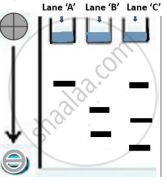Advertisements
Advertisements
Question
Explain the process of DNA replication with the help of a schematic diagram.
Solution
DNA Replication
DNA replication is the phenomenon in which a duplicate copy of DNA is synthesised.
The steps involved in the process of DNA replication are as follows:
-
DNA replication occurs in S-phase of the cell cycle.
-
Enzyme involved: DNA polymerase (DNA dependent DNA polymerase)
-
Replication requires energy.
Source of energy −Deoxyribonucleoside triphosphates (DNTPs) -
DNTPs have dual purposes: act as substrates as well as provide energy
-
Replication initiates at specific regions in DNA called the origin of replication.
-
DNA polymerase polymerises a large number of nucleotides in a very short time.
-
During the course of replication, two parent strands do not completely open, but a small opening forms in which replication occurs. This small opening forms a replication fork.
-
DNA polymerase can polymerise only in one direction, i.e., 5'→3'.
-
Therefore, replication occurs smoothly in 3'to 5'end of DNA (continuous replication, but occurs discontinuously in 5' to 3'end).
-
The discontinuous fragments so formed are joined by DNA ligase.

APPEARS IN
RELATED QUESTIONS
Discuss the role the enzyme DNA ligase plays during DNA replication.
Name two enzymes involved in the process of DNA replication along with their properties.
How was a heavy isotope of nitrogen used to provide experimental evidence to semi-conservative mode of DNA-replication ?
Which of the following phenomena was experimentally proved by Meselson and Stahl?
DNA replication takes place at ______ phase of the cell.
The origin of replication of DNA in E. coli is shown below, Identify the labelled parts (i),(ii), (iii), and (iv)

The experimental proof for semi-conservative replication of DNA was first shown in a ______
Discuss the significance of heavy isotope of nitrogen in the Meselson and Stahl’s experiment.
During which phase of the cell cycle, does DNA replication take place?
The DNA molecules of the same size were extracted from E. coli and Plasmodium vivax. It was discovered that both the DNA molecules had one target site each for the restriction enzyme Hind II. After being digested with Hind II, the DNA fragments were subjected to gel electrophoresis.
With reference to the diagram given below, identify the lanes that represent the DNA fragments of E. coli and Plasmodium vivax respectively. Justify your answer with a reason for each.

